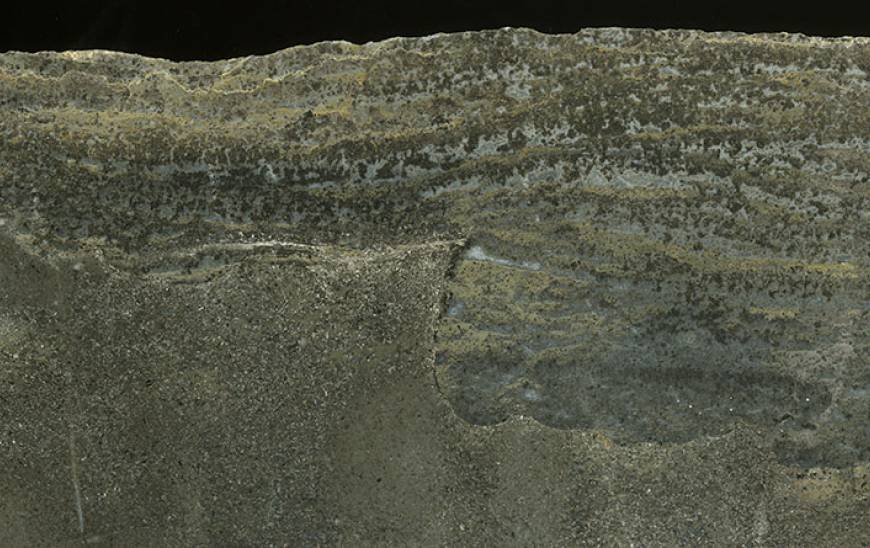The Stanford School of Earth, Energy & Environmental Sciences is now part of the Stanford Doerr School of Sustainability.
This page is currently being maintained for archival purposes only. For the latest information, please visit us here.
Innovative, cross-school geobiology program expands, welcomes two new professors
A relatively new, hybrid academic discipline, geobiology is a concentrated effort a to understand the co-evolution of Earth, life and the interaction of different life forms with Earth materials. New technologies such as gene sequencing and mass spectrometry have helped drive growth in the field in the past two decades. The addition of Kevin Boyce and Paula Welander strengthens Stanford’s presence in the field.
By
Lou Bergeron
October 10, 2013
Jonathan Payne

<p>This slab of limestone rock from China's Guizhou Province records of one of the biggest catastrophes in the history of life on Earth. The lower half of the slab, which dates to the end-Permian extinction 252-million-years-ago, is peppered with the fossils of thousands of tiny marine organisms that lived before the catastrophe. The upper half appears splotchier because the reef ecosystem was replaced by bacterial mats after the extinction event.</p>
In one sense, geobiology has been around as long as there has been life on Earth. But as a field of academic endeavor, it’s really only taken hold in the last 15 to 20 years. So what is this hybrid discipline and why is it flowering now?
“Geobiology is a concentrated effort to understand the co-evolution of Earth and life, the understanding that it is really one system and not two separate ones,” said paleontologist – and geobiologist – Jonathan Payne, associate professor of geological and environmental sciences. The interactions of life forms with Earth materials, including solids, water and atmosphere, result in a variety of natural biogeochemical processes that have shaped the continents, formed the soils, determined the oxidation history of Earth’s atmosphere, resulted in the composition of the oceans, and released toxic elements into groundwater aquifers.
Much of the driving force behind the blossoming of research in geobiology has been new technology. From the biology realm, the advent of gene sequencing enable researchers to delve deeper into the physiology of microbes and learn how their metabolisms influence their environments. From physics, new types of mass spectrometers allow scientists to determine isotope ratios of a multiplicity of elements and track geochemical cycles on a range of time scales, gaining a deeper understanding of how different environments, including oceans and the atmosphere, have changed.
With increasingly powerful desktop computers, researchers can create and manipulate massive databases of organisms, fossil or living, to map the changing distribution of life over time and how that relates to macro-scale changes in climate, plate tectonics and local environment. Supercomputers, which can assess vast ranges of possibilities at high speed, such as the various geometries atoms might form in bonding to one another, have been invaluable to Gordon Brown, chair of the department of geological and environmental sciences, in studying how water and aqueous complexes interact with the surface of a mineral and are affected by microbial organisms in the form of biofilm coatings on mineral surfaces.
Synchrotron x-ray sources, such as the SLAC National Accelerator Laboratory, “allow us to do things we could never have dreamed of doing before,” said Brown, who pioneered the use of extremely intense x-rays from synchrotron radiation in probing the molecular-level environments of atoms and molecules in Earth materials. Such high-energy tools also let researchers precisely map the locations of elements and organic compounds within an individual fossil, helping them understand how ancient animals might have functioned biologically.
The School of Earth Sciences has added to its roster of geobiology researchers with the recent hiring of microbiologist Paula Welander and paleobotanist and MacArthur fellowship recipient Kevin Boyce (see related stories), and is seeking to hire additional geobiology faculty.
The newcomers join a group that includes Chris Francis, associate professor of environmental Earth systems science, who studies microbial geochemical cycling of nitrogen and metals in the environment, and senior faculty Norm Sleep, professor of geophysics, and Dennis Bird, Donald Lowe and Gordon Brown, all professors of geological and environmental sciences.
The greater geobiology umbrella also covers faculty from schools and departments outside Earth Sciences, including Peter Vitousek, professor of biology, who studies nutrient cycling, and Alfred Spormann, professor of civil and environmental engineering, and chemical engineering, whose research includes fundamental metabolic processes of anaerobic microorganisms and their application to bioenergy and bioremediation. The expansion of the program in the School of Earth Sciences opens up opportunities for collaborative research that can connect many research programs within the School as well as in other Stanford schools beyond those that currently exist.
Given the relevance of geobiological research to Earth processes on scales from the atomic to the planetary and over timespans from less than a second to billions of years, this group of researchers should have interesting – and challenging – times ahead of them. Earth sciences in the 20th century were revolutionized by advances in chemistry and physics, said Payne, who counts himself among those who anticipate that many of the fundamental insights that will impact Earth sciences in the 21st century will relate to the role of biology in Earth processes. “After all, when you think about geochemical cycles, almost all of the chemistry that happens is mediated one way or another by organisms,” Payne said.
Lou Bergeron is a science writer based in the San Francisco Bay Area.



